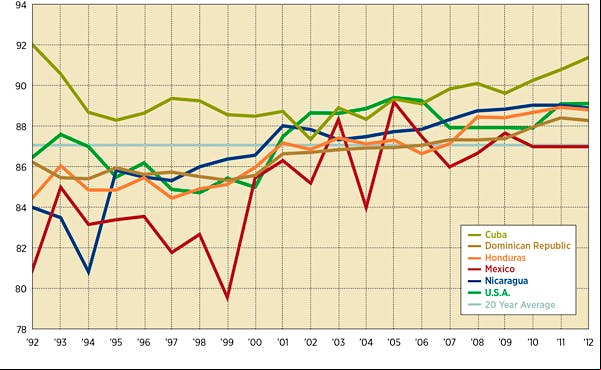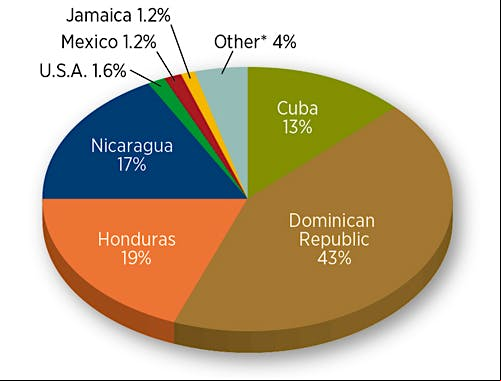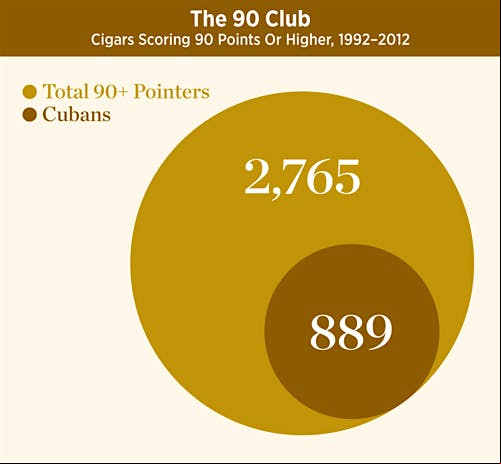20 Years of Tastings

Twenty years ago, Marvin Shanken and Gordon Mott sat down in a boardroom with the people who would become Cigar Aficionado’s first tasting . They closed the doors, lit up and smoked their way through seven of the cigars to be reviewed in the premier issue before nicotine poisoning and a green hue set in. They were off to a rocky start, and the process needed some tweaking.
“I’m pretty sure that’s the last time we ever did that,” says executive editor Gordon Mott. “It became clear immediately that that was not a great way to taste cigars.”
But some things had to be learned the hard way. At the time, the idea of rating cigars was unique. This was pioneering, and sometimes pioneers get sick. And Cigar Aficionado had something else in common with adventurers of the past: they faced pessimism.
“When we told people in the cigar business that we were going to do that, they were very skeptical,” recalls Mott. “First of all, because it had never been done. They, I think, were curious, but I don’t think they really understood what it was we were going to be doing.”
Soon the magazine adopted the method of having tasting ists rate cigars alone in their respective offices, where smoke congestion wouldn’t be such an issue.
Senior editor David Savona recalls the first tastings as an outsider. “I read Cigar Aficionado before I worked at Cigar Aficionado,” he explains. “For me, the ratings demystified the buying process. I my first trips to a cigar shop and I didn’t know what to buy. Then I started reading the magazine. The Fidel Castro issue was my first issue. I picked it up to read the interview, but then I saw all of these ratings. And I said, ‘Wow.’ And I took out a little card, I read some notes—you know coffee or cinnamon or whatever—that sounded pretty tasty. And I wrote down some names. I wrote down some scores of cigars that I could afford, and I went to a smoke shop with my little card and I picked out some cigars, and I had a much better result because I had a little bit of information with me.”
 |
Ratings have also been a source of contention over the years. After the magazine was released, the questions started popping up immediately. “People would ask, ‘I mean how are you tasting all these things? It’s tobacco. It tastes like tobacco,’ ” Mott says. But a standard tasting vocabulary had already been established for wine, spirits and food. As far as Shanken and Mott were concerned, smoke was no different. They were still looking for unique characteristics of aroma, flavor and quality, only in a hand-rolled, cigar.
Charges of favoritism also cropped up. But the editors smoke the cigars in our tastings blind, meaning they have no knowledge of the cigar’s brand, country of origin, component tobaccos or price, which makes the process as objective as possible. Cigars are judged on their merits apart from their origin, so the best tobacco and best cigars rise to the top.
More tweaking would be done. In 1995, as the cigar boom was gathering force, the magazine’s current approach to covering the market began to feel inadequate. Editor and publisher Marvin R. Shanken decided to expand Cigar Aficionado’s coverage with a newsletter. “Marvin wanted us to go out and find the latest, greatest brand that was hitting the market, and do verticals,” says Mott. That’s when Savona ed the team to run Cigar Insider, which published its first issue in January 1996.
Unlike the magazine, Cigar Insider rates entire brands at once, giving a size-by-size comprehensive cross section of the whole cigar line. “You went from having a small and easily understood market to a very crowded market full of unproven cigar brands, and thanks to a vehicle like Cigar Insider, we were able to taste many more of those cigars,” says Savona.
In 2001 the magazine, which had featured one cigar size an issue since its creation, began to embrace the diversity implied by the vertical brand tastings. Instead of 100 or more cigars of one size, each issue of Cigar Aficionado was now featuring more than a dozen robustos, Churchills, corona gordas, figurados and more, showing a cross-section of the market. Readers and cigar makers alike wonder about the mysterious tasting process. It starts at local shops. To recreate the smoking experience that the typical consumer will have, most of what is smoked by the ists is purchased at retailers by our
tasting coordinator—currently me.
Once they’re in the building, the cigars are stripped of their bands and dressed with a number-coded white label. At any given time, our editors can have as many as 50 cigars in their humidors—half of the average tasting for the magazine, plus half of the average tasting for Cigar Insider. Editors smoke in their offices every day, so the smoking conditions remain consistent throughout each test.
Cigars are scored in four categories: appearance, smoking characteristics (which includes how a cigar draws and how it burns), flavor and overall impression. Each category is weighted, with the first having the least importance and the last having the most. The final score is a sum of points awarded in each category, with a greatest possible score of 100. Currently the comprises five , though it has varied between four and six over the years. After the initial run of rankings has been completed, Shanken, Mott or Savona may order additional tastings. If there are any wide variations in the initial round of scoring, (usually between 15 and 20 percent) the cigars will be retasted.
What this means for the is that they’re almost always smoking. More than 800 ratings appear each year in Cigar Aficionado and Cigar Insider. Including resmokes and the test for the Cigar of the Year, each editor is smoking more than 500 cigars a year for testing alone. Most test smoke two to three cigars a day.
Each of the tasters has had several years of smoking experience as well as having undergone a probationary tasting period before their scores are weighted. “Everyone goes through a long training period, even if they have had prior experience, before we begin using their scores on a regular basis,” says Mott.
 |
Once a year, when Cigar Aficionado’s Top 25 Cigars of the Year tasting begins, a list of all cigars that scored at least 90 points is created, from which the first round of candidates is selected. These cigars are smoked to narrow the field. The list is then narrowed again as a second and third round of smokes are carried out to select the winning smoke and rank the other 24.
Frequently the winner is the highest-scoring cigar, though the reserves the right to award Cigar of the Year to a finalist with other factors weighing in its favor. “There’s a subjective quality to it,” says Mott. “Is there some buzz about it? Is it new? Is there something that differentiates it from the others out there? Is the price attractive?”
A look at our scores over the past 20 years provides a snapshot of the industry, and how the market has changed. And the current trends also suggest where the future of the market may be heading. In two decades of tasting, Cuba has been outscored in annual averages by just two countries. According to our database, Cuban scores hit their lowest marks in 2002 and 2004. In 2002, Cuba was sured for the first time by both Nicaragua and the U.S.A. Nicaragua’s streak was short-lived, but the U.S. continued to trade places for best scores with Cuba until 2006, as Cuba slowly climbed back to 90-point levels. Keep in mind, however, that far fewer cigars from the United States were being rated.
The cigar smoker who has been lighting up for the past two decades may look fondly back on the mid-to-late 1990s as a golden age in the cigar industry. The cigar boom, a period described by editors at Cigar Aficionado as having run from 1992 to 1997, brought countless new brands and blends into the humidors of smokers. But that variety and excitement did not necessarily come with quality. Scores from the boom show some of the most turbulent data in our 20-year history.
The 1990s saw both the highest and lowest scores on record. A 99 was given to the Cuban Hoyo de Monterrey Double Corona in the first issue, in 1992. That was the first and only 99 to be given to a cigar in a blind tasting. (Connoisseur’s Corner, where 100-point scores have been meted out, is not a blind tasting.) To date, only two 97-point scores have been given. But the same issue that saw the 99-point blockbuster also contained one of the worst scores in Cigar Aficionado history: the Penamil No. 57 from the Canary Islands. It scored 69 points. Only one other cigar has performed as poorly: the Ornelas No. 1 Vanilla from Mexico, in September of 1996. The ’90s also produced more than 100 cigars scoring less than 80 points, as compared with just 20 since 2000.
“There were a lot of very boring cigars at the time,” says Savona. “New guys came on the market not really knowing what they were doing, trying to mimic a taste, trying to rush the process.” He adds that the demand for tobacco also forced newer blenders into rushing their production. “You can’t just go out and buy four-year-old, five-year-old tobacco. They were forced to buy fresh tobacco, and the newcomers to the market didn’t want to take the necessary steps required to make a good cigar. And so people getting into the market trying to make money would say, ‘I”ll just copy the best-selling cigar on the market.’ ”
Countries like the Canary Islands, Costa Rica, El Salvador, Panama and the Philippines all produced cigars during this period. While a select number of new brands did things the right way, many new-to-the-industry smokes were rushed and unrefined. “I smoking a cigar at a trade show in ’96 or ’97,” recalls Savona. “It was supposed to be a tan wrapper, Connecticut-shade wrapper; it was largely green. The cigar had that green taste to it—it kind of tasted very buggy and sharp. It wasn’t properly fermented, it wasn’t aged—it was bad.” That wasn’t an exception, he notes. “There was a lot of that back then. You don’t see that anymore.”
Another way of looking at the boom is to examine annual average scores across the board. We averaged the scores of all cigars tasted in the magazine and newsletter for each year to assess the overall quality during the 20 years of Cigar Aficionado. The average score for a cigar across all 20 years of data is 87.15 points. This makes determining a trend in quality very simple, because every annual average score prior to 2003 is lower than that average. In 2003, the average began to steadily rise, climbing over 88 points in 2007 and reaching into 89 points for 2011 and, so far, for 2012. The lowest annual average was in 1997 (at the peak of the cigar market in the United States) when the curve dipped to just 85.43 points for the year. That year is among the worst for cigars made in Mexico and the United States, and represents low numbers for the decade for Cuba.
Despite that low, Cuba’s average scores are the highest, currently more than 89 points. Nicaragua and Honduras have shown impressive growth through their own innovations, both rising nearly five points in the two decades on record. The Dominican Republic has nearly always been a steady performer, and after somewhat of a boomtime slump, its cigar ratings for the past two years are higher than they have ever been.
 |
Examining the data shows how cigars have changed in other ways. Ring gauges showed a steady rise over the past two decades. We looked at averages for corona gordas, figurados and robustos. Robustos rose from an average ring gauge of 49.89 in 1994 (no data is available for 1993) to 51.19 ring in 2012. And corona gordas now average more than 52.5 ring, up from just 48 in 1994. The most impressive rise came from figurados, which grew from an average of 47.5 ring gauge in 1993 to more than 53.6 for 2012.
Over the years, some cigar-producing countries have fallen off the radar. Jamaica’s once-vibrant cigar industry is now virtually absent from the cigar world. Mexican cigar shipments have shrunk, and it’s hard to find a cigar that was rolled in the Canary Islands or the Philippines.
Mott has seen all the trends, and likes what they indicate for the future. The moderation of power cigars, the return of some Connecticut shade: he sees these as indicators that the market is staying diverse.
“I think the market needs to respond to consumer tastes, and consumer tastes are not uniform. Different people like different kinds of cigars, and there are people who just prefer that milder smoother smoke, so I’m glad to see that coming back.”
And the scores reflect those successes. Every one of the major countries has improved over the last decade, and the separation between them is getting smaller. Mott says that the best Nicaraguan tobacco can be just as good as the best Dominican, and even the best Cuban.
“People still laugh at us,” he says. “I tell them smoke ‘em blind. Put your Cubans in with your Nicaraguans and Dominicans, without any identifying marks, and when it’s all over tell me what you find. You still may find Cuban cigars that are near the top or at the top of the pile, but they’ll be a lot of things that are either better or right there with them. And it’s just good tobacco.”


















